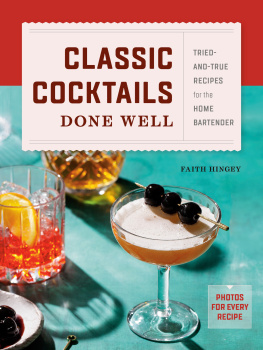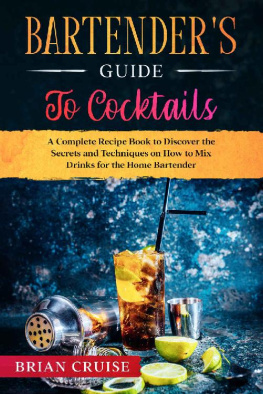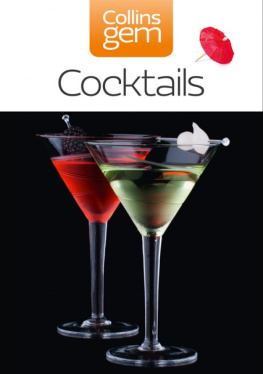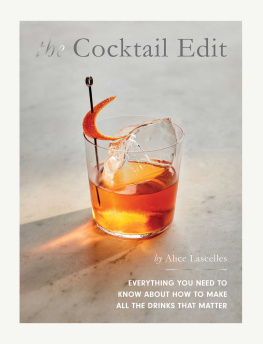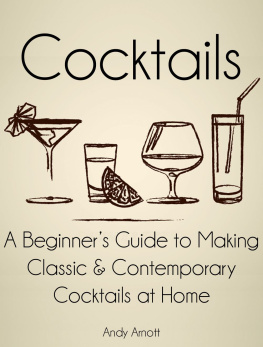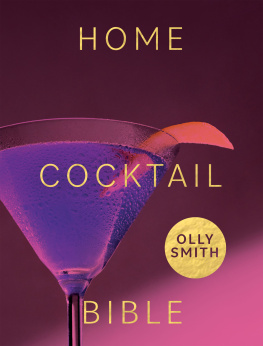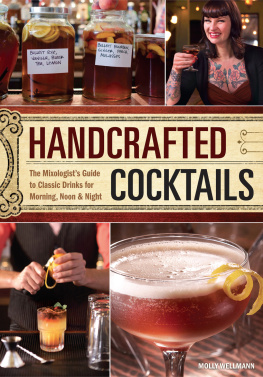Brunch Americano () Champagne Cocktail () Chrysanthemum () French 75 () Garibaldi () Irish Coffee () Negroni Sbagliato () Seelbach () Classic Cocktail Party Daiquiri () Manhattan () Martini () Negroni () Old Fashioned () Sidecar () Tom Collins () Whiskey Sour () Date Night Brandy Crusta () Champagne Cocktail () Clover Club () Honeymoon () Jack Rose () Pink Lady () Daytime Barbecue Brandy Punch () Gin Buck () Gold Rush () Margarita () Moscow Mule () Paloma () Rum Punch () Whiskey Sour () Summer Quenchers Doctor Funk () Gin & Tonic () Gin Buck () Mint Julep () Mojito () Moscow Mule () Paloma () Queens Park Swizzle () Mardi Gras Brandy Crusta () De La Louisiane () Rum Cow () Sazerac () Vieux Carr () Winter Warmers Apple Toddy () Eggnog () Hot Whiskey Punch ()
Chapter One
THE
CLASSICS
AT HOME
Youre likely no stranger to pouring a glass of wine for dinner or popping open a cold beer for a summer barbecue. But perhaps youve always wanted to whip up a Negroni to go with your pasta dinner or serve icy Mint Juleps on a hot afternoon. Learning to make your favorite classic cocktails at home will allow you to elevate just about any activity, whether its movie night with your partner, brunch with friends, or just you and a good book on a lazy evening.
The tips and tricks youll learn in this chapter will have you shaking, stirring, and sipping in style in no time. Studying the Classics Classic cocktails provide a window into the past. Consider the underground bar, the hidden bar behind a rotating bookshelf, or the windowless bar decked out in nautical adornments. These charming places provide a glimpse of life in another era, where drinking a storied libation is really a form of time travel. The modern cocktail library remains deeply rooted in historical drinks. Studying classic recipes provides us with fundamental knowledge for informed experimentations with modern ingredients and styles.
Each cocktail has its own stories to tell, and as you learn them, youll observe trends that evolved alongside historical events. Early American settlers had limited access to European spirits; therefore, many early cocktail recipes included spirits from common crops grown in the New World, such as corn (bourbon) and apples (apple brandy). During American Prohibition, many skilled bartenders left to work in other countries. Their ideas and recipes spread globally, and likewise, they discovered new ingredients that would later be introduced to the American cocktail scene. In the United States, the limited availability of liquormuch of which was tampered with or of questionable originencouraged people to go to great efforts to mask the vile pungency of these spirits. The challenges of this era resulted in notable flavor innovation.
By the mid-1900s, the advent of commercial air travel and American soldiers returning from World War II led to the introduction of new spirits and ideas from around the world, including rums from the Caribbean, vodka from Russia, and imagery and flavors inspired by Polynesia (though it is important to note the dcor associated with American tiki bars is not accurate and generalizes the cultures and peoples of the Pacific Islands). The latter half of the twentieth century saw the emergence of new artificial flavors, thickeners, and bright colors. While interesting, these ingredients didnt make for the best cocktails. Known as the cocktail Dark Ages, this era was marked by radioactive-colored drinks, fake fruit flavorings, and overly sweet drinks. Enter the cocktail revival of the twenty-first century.
Cocktail Styles
As you explore, youll find recurring patterns in the composition of classic cocktailsthese can be considered cocktail archetypes.
Cocktail Styles
As you explore, youll find recurring patterns in the composition of classic cocktailsthese can be considered cocktail archetypes.
Using these archetypes as inspiration, you can confidently design new drinks by substituting one or two ingredients with something similar; for example, replace lemon juice with lime juice, simple syrup with a different sweetener, or brandy with whiskey. Here are some classic styles that recur throughout both historic and modern cocktails: Aperitivo. In Italian tradition, diners often enjoy aperitivo cocktails before meals. These lighter, often bubbly drinks made with bittersweet liqueurs stimulate the appetite. The Americano () represent slightly heavier options. Buck.
The buck is a simple drink primarily composed of a spirit, citrus juice, and ginger beer. This drink works with all sorts of spirits, including gin, bourbon, rum, and Tequila. The type of citrus used will change the balance of the drink; different combinations include the Gin Buck (). Punch. Punch is one of the oldest forms of a mixed alcoholic drink. Earliest references date to the 1600s, and one theory is that the name originates from the Hindi word for five, panch, for its five primary ingredients: alcohol, citrus, sugar, water, and spice.
Punch bowls were shared by Americas founding fathers to celebrate the signing of the Declaration of Independence, British Royal Navy sailors on early colonizing expeditions, and all rungs of society gathering to socialize, gossip, and conspire. From a classic Brandy Punch (), the potential combinations of these festive bowls are endless. Sling. One of the oldest and most rudimentary ways to enhance a spirit, slings are made by adding water, a bit of sugar, and sometimes a spice, such as nutmeg. Examples include the Whiskey Sling (). Cocktail.

